
Original Link: https://www.anandtech.com/show/1671
I've been a Mac/PC user for almost a full year now - it's very hard to believe that last June, I took a (very expensive) gamble on a platform of which I knew nothing about and as a result, emerged with a totally new perspective on something that I had always shunned.
Over the past year, I've brought a handful of Mac related articles to AnandTech, covering everything from the mobile experience of Mac OS X to a look at the new Mac mini. Through it all, my Mac usage has proved itself to be more than just a phase. My Macs are now just as much a part of my daily routine as my PCs.
I'll run into people at trade shows and they are shocked by the fact that I'll actually be typing on a PowerBook (as if it is some sort of a surprise to actually use hardware that you recommend). A few weeks back, I went down to AMD to talk about dual core and I even was commended by a few employees for bringing a "neutral" laptop to AMD, instead of my normal Pentium M based notebook.
The reaction is always interesting, but to me, it's a non-issue; I'm not a switcher, but rather a dual user. As such, I think my perspective on things tends to be a little different than most. The Mac vs. PC debate almost always ends up being just as touchy of a subject as religion or politics, making it difficult to get a balanced perspective on anything relating to what's on the other side of the fence.
I can hardly consider myself an expert on Macs, but I do see myself as someone who is genuinely interested in them; which is why when Apple started talking about the features in Mac OS X Tiger, I found myself just as intrigued as I would be talking to any PC manufacturer about a new product. Apple's PR doesn't work the same way that PC manufacturers do; they are extremely secretive. NDAs and roadmaps just generally don't come from Apple, so I knew that if I wanted to get early experience with Tiger, I would have to go around Apple PR.
Luckily, early on in Tiger's development, Apple created a Tiger Early Start program for developers through their Apple Developer Connection (ADC) website. The Early Start program was designed for developers to get access to Tiger and to be able to develop for all of its new technologies. For me, it was a way to get access to monthly builds of Tiger and gain a ton of experience with the OS over the past several months.
In order to get a good feel for the OS, I had to make sure that I had Tiger installed on a computer that I used regularly, but I didn't dare install a very beta OS on my main desktop. Instead, I made my PowerBook the Tiger test bed, since it is something that I use regularly, yet on which I do not store extremely important data (I always had a copy of everything on my desktop and on my file server). So, for the past several months, I used Tiger on my PowerBook, updating it whenever there was a new beta released. However, I did wait to finish this article until I had spent a good amount of time with the final build of Tiger, which begins shipping today (although, thankfully, some copies were shipped out earlier than expected). So, although a lot of the work that went into this article was done on beta copies of Tiger, the final article wasn't written until I'd used the final build of the OS.
As with previous versions of the Mac OS X, version 10.4 (Tiger) isn't a free upgrade; Tiger is priced at $129. As with most Apple products, there are some hefty savings to be had if you are a student/educator and are purchasing through Apple's online store or in an actual Apple store. If you are eligible for a student discount, Tiger's price tag drops down to just $69.
Tiger's student pricing was a trigger for me to talk about how much I do appreciate Apple's pricing on their software; while I agree that their higher end hardware is a bit steep, their software licenses are extremely reasonable. I didn't think twice about ordering the iWork suite as soon as it was launched because I knew that it had applications I wanted and I knew that the price would be reasonable. I can't say the same about successive iterations of Microsoft Office, for example (or even individual Office applications). Apple doesn't do much to combat piracy of their software, and part of the reason is that they don't have such a large user base where piracy is as big of an issue as it is in the Windows world. But, it is also worth noting that given the price of most Apple software (even their professional software is priced very reasonably), it isn't something that most users would balk at.
Given that Tiger is basically the price of a modest hardware upgrade, a lot of the OS must be evaluated on a value basis for upgraders. While my previous Mac articles have focused on the entire package of hardware and software, this one is definitely different as the evaluation is done from the standpoint of an OS X 10.3 (Panther) user. Obviously, all new Macs will come with Tiger, so the cost of the OS is already included in the total package price; but for everyone else who, like me, has purchased a relatively new Mac in recent history, there is a definite purchasing decision surrounding the move to Tiger.
How New is Tiger?
Cost of entry aside, there are a number of feature and performance improvements in Tiger that are worthy of evaluation. Quantifying the "newness" of Tiger is difficult; Apple put together a list of over 200 new features that made it in to Tiger, but some of the list appears to be more of a way to increase "feature count" rather than listing truly individual features.At the same time, there are a number of changes that have been made in Tiger that aren't feature-worthy, but are either positive bug fixes, or negative changes in the way that aspects of the OS work.
I've done my best to go through both the little things and the major changes in Tiger, but as is the case with all of these Mac articles, I always finish the article feeling like there's still a lot more to talk about. These Mac articles have become easier to write since the first nerve-racking one, but they continue to be uniquely difficult as a lot of it is just trying to convey feelings of an experience.
That being said, if you are new to the Mac platform or are interested in knowing how I ended up in a situation where I'd be interested in reviewing Apple's latest OS, I strongly suggest that you go back and read my first two Mac experience articles. For everyone else, let's get right to it.
Installing Tiger
The Tiger installation process is extremely quick and painless. Although you can get a similarly simple installation method with Windows, if you enable the unattended setup feature, what's important is that stock (with no modifications) Tiger offers a very painless install. This isn't a new feature in Tiger, as Panther appears to install just as easily.With Macs, since there's no exposed boot menu, you have to hold down the "c" key while starting your machine to tell it to boot from whatever is in the CD/DVD drive. Doing so works flawlessly (even on non-Apple keyboards, if you were wondering), and you are greeted with a familiar screen.
You select the language in which you'd like to proceed, agree to the software license, select the hard drive to which to install, and then the type of installation that you'd like to perform. The type of installation is where things differ a bit from Windows. The Tiger installer offers three options: Upgrade, Archive & Install or Erase & Install.
The Upgrade and Erase & Install options are pretty self-explanatory. It is the Archive & Install option that is unique to OS X. The installer describes this option as doing the following: "Moves existing System files to a folder named Previous System, then installs a new copy of Mac OS X. You cannot start up your computer using the Previous System folder." You can also check an option that will copy all of your users, their home folders, and their network settings to the new install - effectively giving you all of the benefits of an Update, but with the cleanliness of a clean install.
Although not explicitly mentioned here, most of your applications should work just fine after the Archive & Install option. Remember that for the most part, OS X applications are fairly self-contained and modify very little outside of your Applications folder, so moving your old System files shouldn't change the behavior of most applications. Some applications don't behave properly after this type of an install. I had to re-install Stuffit Expander and there is a known issue with Photoshop CS and no longer opening images dragged onto its icon in the Dock after an Archive & Install. But for the most part, applications were fairly well behaved.
I've tried all install options and have pretty much settled on Archive & Install as my favorite of the bunch for the reasons mentioned above. One thing that I was curious about was how long the OS X Tiger install would take, and so I conducted a timed install procedure on three machines: a Powermac G5 2.5GHz, a Mac mini and a 15" PowerBook G4.
Both the mini and the PowerBook G4 came in with identical install times of 36 minutes, while the G5 installed Tiger in 22 minutes. What's also particularly nice and quick about the Tiger install is that the procedure is complete without any reboots until the very end; after the OS is installed, a single reboot will drop you into the brand new OS.
Bugs Fixed and Created
While Tiger is mostly a feature release of OS X, there are a handful of bugs that are fixed, but unfortunately, also created with the updated OS.In my review of the mobile experience of Panther, I complained about how I could never get the Keychain manager to remember my user names and passwords when connecting to any of my Windows shares. It turns out that as long as I sent the password as plain text in the connection request, I'd never get asked for a user name and password again - but that's obviously not the most desirable solution.
In Tiger, the password problem is thankfully fixed - I can connect to any of my Windows shares without having to keep on reminding the Keychain manager to remember my user name and password.

Further indication of Tiger's hurried release is the fact that Quartz 2D Extreme, the complete handling of UI rendering and compositing by the GPU, is not enabled in the release version of OS X Tiger. As such, users of Quartz 2D Extreme supported GPUs gain no performance benefits in Tiger as the CPU is still left to handle all UI rendering and the GPU handles all compositing after the CPU renders the interfaces to textures in AGP memory. The only benefit modern day GPUs offer in Tiger (other than their improved performance in 3D applications) is that there are certain visual effects that are only enabled if you have a GPU that supports Tiger's Core Image. For example, when dropping a widget onto the Dashboard, you get a very nice ripply-wave effect on GPUs that support Core Image; and on those that don't, there's no effect. But from a performance standpoint, there's no benefit to either ATI's Radeon X800 XT Mac Edition or NVIDIA's GeForce 6800 Ultra DDL.
Although it's most definitely an issue related to meeting Tiger's 1H'05 release schedule, I've always thought that Quartz 2D Extreme was best paired with PCI Express. Given that Quartz 2D Extreme requires that all UI elements are rendered by the GPU, including every last character that appears on the screen, you can expect the size of your local frame buffer to play quite a major role in performance. Obviously, not everything will be stored locally to the GPU, and thus, there will be times when the GPU is rendering or compositing data that is located within system memory, which at this stage means that the GPU has to go over a very slow AGP 8X bus (2.1GB/s) to get to the data that it needs. With PCI Express, the GPU to system memory bandwidth is significantly increased, which has enabled technologies such as NVIDIA's Turbo Cache to gain a foothold, where things like AGP GART could not. Although it's unthinkable that Apple would revise Quartz 2D Extreme to be a PCI Express-only technology, the fact of the matter is that it should be much better paired with a PCI Express based G5.
Tiger also seems rushed in the sense that it's not a drastic shift to 64-bit computing; Tiger adds the ability for individual processes to have access to more than 4GB of memory. As can be expected, any process using the 64-bit memory space can only talk to 64-bit libraries, which at present, doesn't include any UI libraries. The end result is that you can have a 64-bit process, but it has to talk to a 32-bit UI process. There are even more limitations beyond this, but the basic impression that I get from Tiger is that Apple is taking a much more transitional approach to the move to a full 64-bit OS than Microsoft. In fact, if it weren't for AMD, I wouldn't be too surprised if Microsoft's move to 64-bit would be much more similar to Apple's. The reality of the situation is that for the majority of users, 64-bit memory addressability isn't going to be a necessity for another few years still. Instead of focusing a lot of attention on 64-bit today, Apple appears to be making a transition towards the goal of making the Mac OS a full 64-bit OS, but with Tiger, we are far from there yet. Next week, you will be able to read my impressions of Windows XP x64 Edition, and from my experience with that, desktop users aren't missing anything from Tiger, being somewhat limited in its "64-bitness".
So, what are these bugs to which I keep alluding in Tiger? For starters, applications do crash in Tiger (which happened in Panther as well), but now, Tiger allows you to "Reopen" the application after telling you that it's crashed - how nice of it, right? Well, the problem is that occasionally, after re-opening an application that just crashed, Tiger will pop up a window and ask you if you want to keep the new settings that have been applied for the application that you're using. What this appears to do is tell the application to revert to its default settings, but the question clearly doesn't word it like that. The bug thickens, however; sometimes clicking "yes" or "no" is not sufficient enough, and more and more copies of the dialog box will appear. This is a problem that I started noticing in some of the later ADC betas, but I figured it would just get fixed on its own. While it doesn't happen nearly as much as it used to, it definitely does happen even in the final build of Tiger. The only solution to the problem is to hit Cmd + Q to quit out of the application after you've quickly hit "yes" or "no" a bunch of times to clear the stack of dialog boxes. It's annoying, but luckily, I haven't had it happen to me too often.
Then, there's a new bug with Dock magnification that wasn't present in Panther. I'll talk about this one in greater detail in the section on what's new in Finder. And there are some minor bugs related to Dashboard and some of its individual widgets that I'll also go over later in the article.
Tiger is a lot more polished than it was during any stage of the beta program, but I would hardly call it a finished product ready for retail release. One aspect of the entire Mac OS X experience has been that everything just seems to work the way it should, but with a buggy OS (regardless of how minor many of the bugs are), that experience is challenged. Given the amount of time that Apple invested in touting not only Tiger's 1H'05 release date, but taunting Microsoft's delays with Longhorn, it's not surprising that aspects of Tiger appear rushed. When I first heard rumors that OS X 10.4.1 was being worked on immediately after releasing Tiger to manufacturing, I feared that this may happen. The good news is that hopefully, 10.4.1 will address these issues and hopefully with the team hard at work at it, it will be out sooner rather than later. But waiting for a patch to an OS before calling it final is usually something that we do in the Windows world, not something that Apple needs to be copying.
Tiger: The Overprotective Parent?
There are a couple of extremely Windows-like elements to Tiger that have bothered me beyond belief.One thing that I never really appreciated about Panther, but was always there, was the fact that the OS rarely second-guessed me about things. With all of the issues surrounding security, spyware and viruses and Windows, the latest versions of Windows have become a little too big-brotherish. I was always warned about not letting Windows update my computer automatically and a clean install of Windows would always tell me that I shouldn't be playing around with system files. As a Windows user, I just put up with the OS telling me that I should be careful when downloading files or removing certain programs. But with Panther, most of those warnings were gone; I'd get a message making sure that I knew I was deleting something, but that's about as far as things would go. With Tiger, it looks like Apple is playing the role of big brother a little more.
The changes aren't overboard, but they are little annoyances designed to protect the user from his/her actions - just the type of thing that I hate to see. First of all, if you double-click a zip attachment in Mail 2.0, you now get a warning that tells you that your file "may contain an application". You can get around this warning by just telling Mail to save the attachment(s) and open them yourself in Finder. If you do it that way, Mail thinks that you know what you're doing and doesn't play its motherly role.


Tiger's Finder
For the most part, Finder's appearance hasn't changed with Tiger. The Apple menu in the top left hand corner sports a new brighter blue color, as does the Spotlight button in the opposing corner. All highlight colors are now that same shade of blue, which is a nice, but a very small change.| Mac OS X Tiger | Mac OS X Panther |
 |
 |
Earlier betas did have some differences with how Finder worked, but thankfully, the decision was made to keep things relatively static from Panther to Tiger.
The biggest functional change to Finder is the support for Smart Folders. I will discuss the technology behind Smart Folders in greater depth when I talk about Tiger's Spotlight search engine, but know that Smart Folders are dynamic entities that behave as a folder would, but aren't actual folders.




The Dock has a few changes in Tiger. Most notably is that now when you right-click on any item in the Dock, you have the ability to select Open at Login, which will launch the application whenever you login to Tiger. It's a nice option to be able to have those applications that you always open upon startup to be open automatically at Login (e.g. for me, that would be Mail, iChat, Adium X and Safari).


The Dock remains magnified even when our window focus is elsewhere.
My final complaint about the Finder in Tiger is the way deleted folders are handled if a window showing the folder's contents is still visible. For example, in Panther, if I had a folder called Useless Stuff open and I decided to delete the folder, doing so would cause the open Useless Stuff window to disappear as it had now been dragged into the Trash. In Tiger, the Useless Stuff window will still remain open, although its path will have changed as it is now in the Trash. To me, that doesn't seem particularly intuitive and it's something that does bug me a lot in Tiger.
Spotlight
The other big feature of Tiger is its system-wide, fully indexed meta-data based search engine called Spotlight. Apple best describes what now happens in Tiger to support Spotlight: "Every time a file is created, saved, moved, copied, or deleted, the file system automatically ensures that the file is properly indexed, cataloged, and ready for whatever search query might be issued..."Because of the constant indexing of every file written to the hard drive(s) in your Mac, searches using Spotlight complete in somewhere between 1 - 2 seconds on a G5, and a little longer on the mini or on a PowerBook G4. Compared to the "old way" of searching, Spotlight searches are virtually instantaneous and they produce far more relevant results. The first time that you start up Tiger, Spotlight will take time to crunch away and index your entire drive. This process ended up taking less than 20 minutes on all of the machines that I tested, as long as I left them alone while it was working (and less than 10 minutes on the G5s).

The search box looks no different than a Google search box in modern day browsers; of course, with the exception of its distinct blue surrounding color. As you type in your search query, Spotlight immediately gets to work - the results list is populated as you continue to type out your query.

The Spotlight window gives you even more options, such as looking at all of the results, how you want to group or sort the results, and even where you'd like to search. It's rare that I have to resort to looking through the Spotlight window to find what I need (the top hits are usually spot-on for me), but when I do, it's very handy.

Spotlight's true power is in the fact that it is fully extensible - so application developers can harness Spotlight's power within their own applications. Apple does a great job of this in many of their applications that are updated with Tiger. Mail 2.0 now searches through all of your mailboxes using Spotlight - so the Find function is actually useful now. Finder takes advantage of Spotlight in that you can now create Smart Folders that dynamically populate themselves based on search criteria. For example, I'm horrendously bad at making sure that I keep all videos I download in one location; little ones that I don't care much about remain in my downloads folder, while others that I find particularly funny or worthwhile will be stored somewhere else. I can now create a Smart Folder that is just for movies, so whenever a movie file is downloaded, created or edited, Smart Folder will update itself to include that movie file. While Smart Folders may look and work just like folders, they are still just a display of Spotlight search results, and as such, you can't peer into them at the command prompt, for example.
Spotlight will even search through System Preferences - just search for what you're trying to do (e.g. Dashboard keyboard shortcut) and a real-time spotlight effect will appear over the icons that contain options matching your search criteria. This feature of Spotlight is particularly useful for beginners and folks who aren't as familiar with OS X System Preferences.

More than anything, Spotlight has become my number one choice of navigating through my file system or even navigating normally through most applications. For example, I was reading through my emails on my PowerBook one day and I wanted to reply to an email from a person named Terri. I knew I only had one email from her in my Inbox, but it was further down in my inbox - I'd just have to scroll to it. On the PowerBook, instead of moving my hand down to the trackpad, I found it quick to hit Cmd + Space, type in "Terri", and then just arrow down to her email and hit enter. It may seem like a lot of steps compared to just scrolling down, but it actually took me less time - it's that fast.
You can actually add meta-data for Spotlight to search by adding "Spotlight Comments" in the info pane of any file.


From a productivity standpoint, Spotlight is a huge feature - it really does change the way that you navigate and is especially useful on platforms where navigation is more of a pain (e.g. notebooks). One thing I realized is that Spotlight is the type of feature that's tough to appreciate if you actually use it on a regular basis. Before I started using Tiger, I craved the feature, but now that I've been using it on a regular basis, it tends to lose its initial excitement and becomes another tool that just works. It's when you don't have Spotlight that you really begin to appreciate its power and potential. The next-generation of applications designed for Tiger should hopefully take full advantage of Spotlight, making searching for anything on your computer just as easy and as accurate as finding something on the web.
Dashboard

A Dashboard widget can be anything, but for the sake of providing an actual definition, I'll say what a Dashboard widget means to me. To me, a Dashboard widget is a small application that would normally clutter up your desktop, yet provides one specific, but very useful task. For example, Tiger comes with a Weather widget that tells you the current and 6-day forecast for any area. The Weather widget itself is nothing more than a client interface to AccuWeather.com, where it gets all of its data, but the widget itself saves you from visiting that website just to get today's weather. Instead, all you have to do is pull up the Dashboard and you get the information that you need - all without cluttering up your actual desktop. This brings up yet another question, how do you pull up your Dashboard? By hitting F12, of course.
You'll remember from my previous articles (or by simply being an OS X user) that, by default, function keys F9 - F11 are mapped to Exposé. Thus, using F12 to bring up Dashboard seems to just fit. Hitting F12 will slightly dim your actual desktop and bring into the foreground any and all active Dashboard widgets.
There are a number of ways that you can hide the Dashboard; you can hit F12 again, activate any of the Exposé functions, Cmd + Tab out of the Dashboard (note that the Dashboard doesn't appear in the Cmd + Tab list of applications), or just click on an empty portion of the Dashboard. As always, Apple does their best to give you as many ways to accomplish the same end result as possible - to meet everyone's unique needs.
By default, Dashboard sits as an active icon in the Dock directly to the right of the Finder icon. You can remove the Dashboard from the Dock, but some will appreciate the ability to click down there to activate it. As with any of the Exposé functions, you can also activate the Dashboard using a mouse button or a corner of your screen - all customizable using the Dashboard & Exposé preferences pane.
Some widgets can be configured (e.g. the Phone Book widget requires that you type in your zip code so that it knows the area in which to search) and you access their settings by hovering over the widget until a little "i" appears. Clicking the "i" will flip the widget over and reveal its settings pane. Click "done" to flip the widget back over again. Not only is the 3D flipping effect a nice one, keeping the settings hidden like that keeps the Dashboard looking very simple and very to the point.


Most importantly, the last Dashboard widget that you used still remains the active one for the next time when you activate the Dashboard. So, if I'm crunching away using the Calculator widget and switch back to my desktop to remind myself of a percentage I wanted to calculate, I just hit F12 again and start typing away in the Calculator once more.
It is worth noting that a nearly identical offering has been out for OS X and Windows for quite some time now called Konfabulator. The free utility offers functionality identical to Dashboard, and a very wide selection of widgets - although, they don't all have the polish of those that are shipped with Tiger.
To me, the biggest attraction to Dashboard is the fact that you move very useful items off of your desktop and onto basically a separate desktop that is very easy to access. Apple provides a total of 14 widgets with Tiger (and a link to download many, many more) and they also provide excellent documentation for developers to make their own widgets. Here are the widgets that are included in Tiger:
Address Book
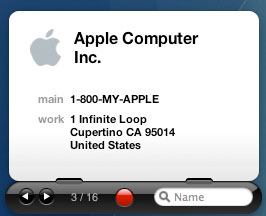
Calculator
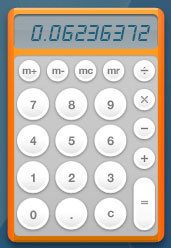
Calendar

As a Windows user, I always found myself clicking on the clock in the Taskbar to bring up a calendar for this very purpose, so I have extra appreciation for this particular widget.
Dictionary
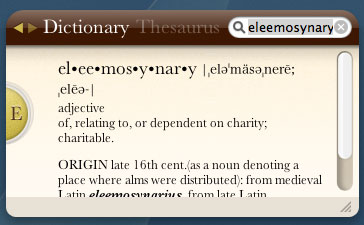
Flight Tracker
![]()
iTunes
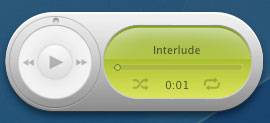
Phone Book

Stickies
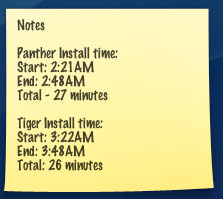
Stocks
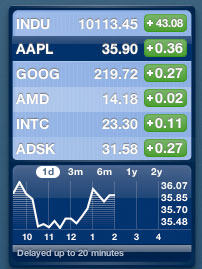
The graphing capabilities aren't anything too impressive though, as you have no option for a weekly graph. The data is all pulled from Quote.com.
Tile Game
Quite possibly the most useless widget to me is the Tile Game. I guess that's just not the type of gaming I'm into. But for those who do enjoy it, the Tile Game widget is interesting, although it goes against what seems to be one of the major purposes of the Dashboard - for items that require very little interaction/just a quick glance.
Translation
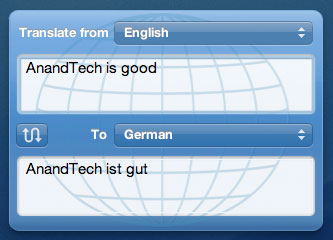
Chinese (simplified), Chinese (traditional), Dutch, English, French, German, Greek, Italian, Japanese, Korean, Portuguese, Russian and Spanish. Unfortunately, I'm not fluent in all of those languages, so I can't attest to how accurate of a widget it is, but it seemed to handle English to German translation relatively well.
You can type in words or paste full paragraphs, although there is a 40-word limit. So, if you're looking to translate an entire paper, you're going to have to use something else.
Unit Converter
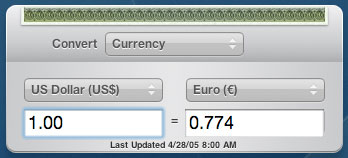
Weather

World Clock
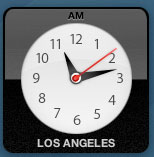
For me, I use Dashboard on a very regular basis - I'd say that I probably use it more than any of the new features in Tiger, since I always check in with widgets on the Dashboard multiple times throughout the day. If Apple's goal with Dashboard was to reduce desktop clutter and improve productivity in the sense that you don't have to waste time getting information and utilities from various websites, then Dashboard is an astounding success.
Dashboard isn't entirely flawless. Like many aspects of Tiger, there are some annoyances with Dashboard. My major issue with Dashboard is mostly visible on the PowerBook, where I'm not always connected to the Internet. My problem is that none of the data in any of the Dashboard widgets appears to be cached, so when you hit F12 on the PowerBook, there is a very annoying delay where all of the widgets that rely on an active Internet connection for their data (e.g. most of them) appear blank for a few seconds.
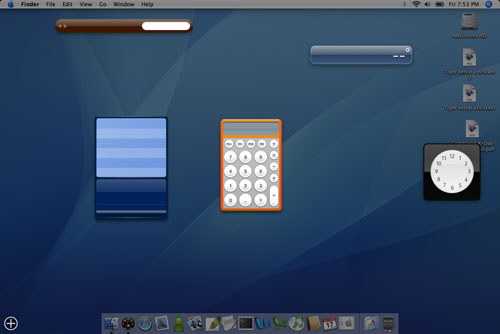
This is the result when hitting F12 on the PowerBook during the first few seconds of coming out of its slumber.
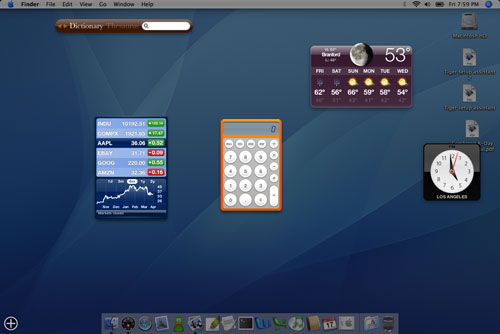
After a few seconds, this finally appears. Note how the name of the Dictionary/Thesaurus widget doesn't actually appear until now.
Also during this period while Dashboard attempts to update all of the active widgets, you may have the desire to just go back to your desktop, which isn't always possible. Hitting F12 immediately after looking at the Dashboard and finding nothing but blank widgets won't always work. Most of the time, you have to wait a few seconds before you regain control over that aspect of your system. I have to reiterate that these issues are only visible on the PowerBook; on a desktop that's always on (or a PowerBook that is always connected to the Internet and doesn't go to sleep), the Dashboard data is never touched and the widgets always remain full of information.
Some of the widgets will still have to update themselves after you have pressed F12, even if you are currently connected to the Internet. It appears that although the widgets are always loaded in memory, they don't eat up any CPU time; meaning that they don't constantly remain updated while Dashboard is inactive. For example, my computer remains on while I sleep, and when I get up in the morning, one of the first things that I do is bring up the Dashboard to check the Weather widget to find out how cold it's going to be in CT today. For the first second or so, the weather still reads as yesterday's temperatures, before it updates itself and displays today's forecast. The same applies to the clocks; even while regularly using the computer, the Clock widgets don't constantly update themselves. So, when I hit F12, the clocks take a second or two to update before displaying the correct time for whatever time zone that I have them set. I guess in the end, I would rather not have the Dashboard impact performance elsewhere in the system by dedicating CPU resources to updating each and every widget, but if there was a way around these issues without impacting the experience in the rest of the OS, it would be nice to see that implemented. Maybe Apple will need to move to dual core dual G5s so that one of the four cores can be used to keep Dashboard updated at all times.
Safari RSS (aka Safari 2)
In my first encounter with a Mac, I ragged on Safari for being a major disappointment under OS X; the browser looked great and was very user friendly, but it was sluggish and had a handful of annoying incompatibilities. With Tiger, Apple ships an updated version of Safari called Safari RSS.As its name implies, Safari RSS now allows you to read RSS feeds directly within the browser. Safari's integrated RSS reader is easy to read, well laid out, and works well within the Safari interface. I haven't really caught the RSS bug just yet, but Safari's implementation is quite nice. The only problem I have with it is that if a site offers more than one RSS feed, there's no way of accessing any but the first RSS feed listed in the site's code (Firefox will let you subscribe to any of multiple RSS feeds off of a single site without any problems).

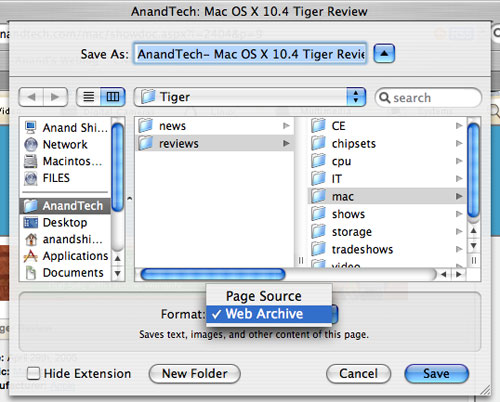
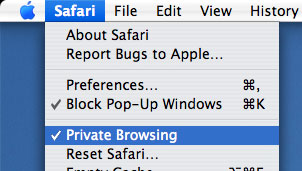
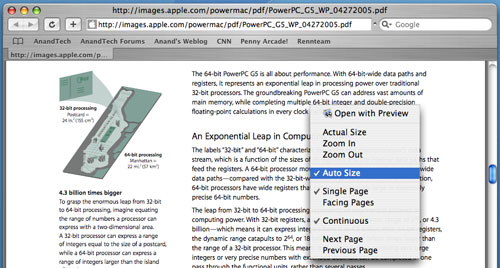
Shortly before Tiger's official ship date, Apple released a brand new update of Safari for Panther users - Safari 1.3. Safari 1.3 (a part of OS X 10.3.9) offered some major improvements, mostly in the areas of performance and stability. The latest version of Safari finally solved the vast majority of my performance complaints about the browser, and as you would expect, Safari 1.3 under Panther performs quite similarly to Safari RSS under Tiger.
There are many cases now where Safari is actually faster than Firefox, but there are still some situations where Firefox is faster. What is most important is that Safari no longer feels like a slow browser, which greatly contributes to the subjective take on how fast modern day Macs happen to be - an area of weakness that can use any sort of improvement as is possible.
Safari's compatibility has come to bother me on a few occasions. Although, all of the sites that originally had Safari incompatibilities when I first started using the browser about a year ago have since been fixed. There still continue to be day-to-day incompatibilities with Safari; whenever I visit a website and things don't work exactly the way that I'd assume they would, I first have to open the page in Firefox to make sure it's not Safari causing the problems. This usually is a problem whenever I'm ordering something online or filling out any sort of form using Safari. If the submit button doesn't do anything or I get an error telling me that I didn't fill something out, yet I clearly did, then I know that I've been hit with another Safari incompatibility. For the most part, I'd say that Safari works fine on 100% of the sites that I read on a regular basis; however, it's the random sites or the times when I'm using sites that I rarely use that I sometimes encounter incompatibilities. They are annoying, but it's something that I've come to live with.
By far, the biggest problem with Safari that I've had is that the browser crashes, a lot, with certain web pages. Sometimes the crashing appears to be related to Flash; other times, it appears to be Javascript related and then there are other times when I can't even begin to pinpoint why it crashes. The problem seemed to have developed over time (possibly being made worse by subsequent OS X patches or just seeming that way by increased use of the browser), but it is definitely present on all systems. One thing that makes it difficult to diagnose is that I often have a large number of tabs open at once, and any one of those tabs could cause the instability. Needless to say, losing all open Safari tabs is a bit of a pain, and it's unfortunately something that hasn't been completely fixed in Safari RSS, but it does seem to have been somewhat addressed. I've only had a couple of crashes on the final version of Safari RSS and I've been using it a lot in preparation for this review.
I've mentioned in previous articles that I've always stuck with Safari because its look, feel and behavior matched what I'd expect from all other OS X applications. With Safari RSS, the decision to use Safari over something like Firefox or Camino (both of which I keep installed) is much less of a tradeoff. I only wish that Apple would add support for "find as you type" to Safari - it's the one feature that I truly do miss from Firefox.
Mail 2.0
Mail was one of my original favorites of OS X, although the application itself looked extremely simple. It quickly proved to be much more robust and much less of a resource hog than my previous client, Outlook. As one of my favorite applications under OS X, I was curious to play with Mail 2.0 in Tiger, which has had a handful of changes.When starting up Mail for the first time, it will take a few minutes to import all of your old emails into the new version of Mail.
The most noticeable change in Tiger is that Mail has a brand new interface. The new interface is strange - I'm not totally sure what Apple's trying to do with it. It looks good, but it definitely stands out from the rest of the OS. Although the look and feel of Mail has changed, the icons haven't really, which makes them feel somewhat out of place in this new version. I may get used to them over time, but at this point, I'm not. The new top toolbar is quite possibly one of the biggest positive visual improvements to Mail over its predecessor.
Mac OS X Panther Mail
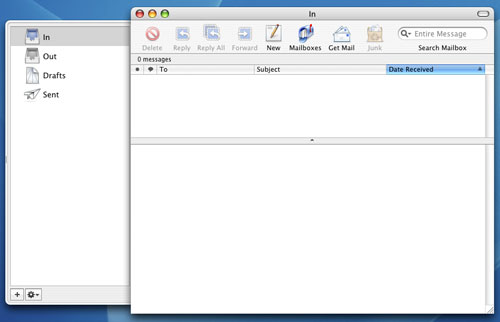
Mac OS X Tiger Mail
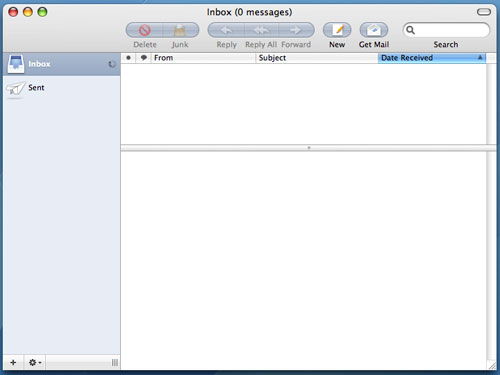
There are smaller interface changes that are nice, such as the new save attachment button. The new button is a lot cleaner/simpler looking now, mostly because it's small. It's a minor change, but I like it.
Mac OS X Panther - Mail Save Attachment button
Mac OS X Tiger - Mail Save Attachment button
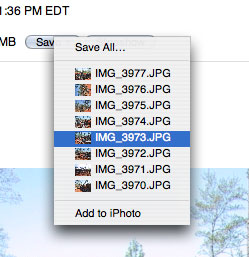



The other major changes to Mail are Spotlight related, as all searching in Mail 2.0 is driven by Spotlight. This comes as a huge relief to me as I found Mail's original search to be fast, but lacking in accuracy, not to mention that it was a pain to switch between the fields that I was searching. With Mail 2.0, searching is infinitely more useful. First of all, you no longer have to select where you want to search from a drop-down list. As soon as you start a search, a bar appears that lets you select where to search, and what to search. Unfortunately, searching the "Entire Message" still doesn't catch items that are only in the Subject field and you can't select both, which is a bit of a pain. You can also save your searches as Smart Mailboxes, which are similar to the Smart Folders in the new Finder.
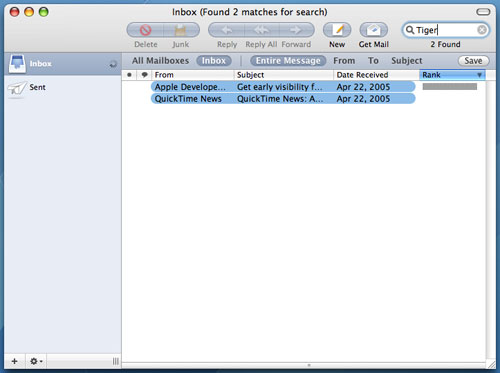
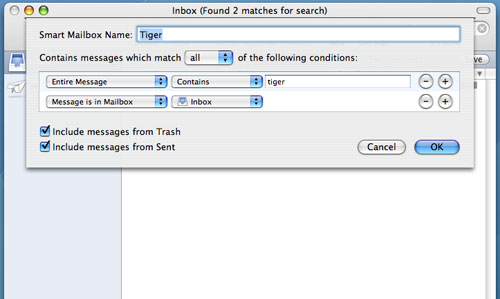
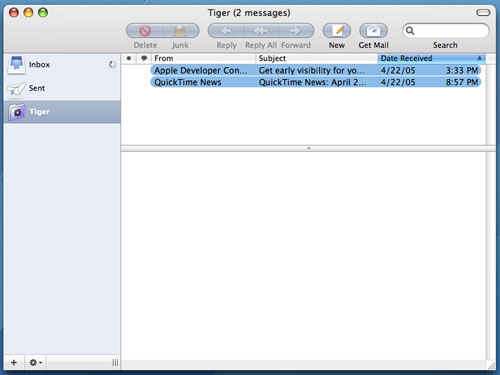
Smart Mailboxes, on the other hand, aren't actually physical Mailboxes - they are just saved searches (much like Smart Folders). So in this case, Smart Mailboxes do still allow the new mail notifier in the Dock to be triggered by manufacturer emails coming in. The downside is that my Inbox doesn't remain as clean and uncluttered. But with a large number of Smart Mailboxes, I could theoretically get things to the point where I'd rarely have to check my main Inbox for email. It's something I still have to play around with more at this point, but the flexibility of Smart Mailboxes is definitely appreciated.
There are other minor functionality tweaks to Mail 2.0, such as a new compose window. When composing emails, you now have the option of adding new fields directly from the compose window, such as a Bcc address field or a Reply-To address field. Also, hitting Command + i in Mail 2.0 now brings up an Account Info pane that will give you a list of all messages on your mail server, as well as let you customize mailbox behaviors. It's a neat panel that can be useful if you have your machine set to leave your POP email account messages on the server for a certain period of time.
Overall, I'd say that Mail 2.0 in Tiger is a reasonable improvement, but mostly because of the features that Spotlight offers. The addition of the slideshow viewing mode is also useful, but the interface tweaks aren't anything to get too excited about in my book. In some cases, I preferred the old, simpler look of Mail, while in others, I welcome the new client. In the end, it still does the same great job that it always did; it's just that now, I can search a lot better and it's easier dealing with pictures in emails.
Automator
One feature that's always intrigued me about OS X is how powerful yet fairly accessible of a scripting language AppleScript happens to be. Despite its relative ease of use, I hardly ever found myself using AppleScript to get things done. I never seemed to have enough time to sit down and become comfortable enough with the language, regardless of how much easier it would make my life.
Tiger brings another tool to the table that can work either with or in lieu of AppleScript for those who aren't interested in learning the language, and that tool is called Automator. One underlying theme of features like Automator and Dashboard in Tiger is to take functionality that was essentially present in Panther, and make it something that's accessible and actually used by the masses in Tiger. With Dashboard, Apple has taken many of the features of Sherlock - a rarely used and rarely talked about tool in Panther, and re-packaged them in a much more user friendly environment that is Dashboard. With Automator, Apple has taken many of the types of tasks that you can accomplish using AppleScript and made them infinitely more user friendly.
To the end user, Automator is basically a drag-'n-drop batch job generator that happens to be very flexible. Automator allows you to create a workflow of actions, with each action performing specific tasks on its inputs and passing it along to the next action. For example, one of the actions that ships with Tiger is an action to get all image URLs from a web page in Safari. With all of the image URLs, you can then feed them into another action to download all of the images to a specific folder. You can then feed all of those images that you've just downloaded into another action that scales all images to a certain size. The workflow that I've just described can be even more complicated, taking the scaled images and doing pretty much whatever you'd like with them - you can even nest workflows inside of other workflows to achieve even more robust results. What's most important about Automator is that all of this is done in an extremely simple and easy-to-use manner.
You select the category of action from the left; the actions are grouped according to what applications with which they are associated. Then, you select what action you want to perform and drag it into the right pane to add it to your workflow. The workflow is linear and doesn't branch, so anything at the top of the workflow feeds into anything below it. Automator handles all error checking and will warn you if your workflow is going to do something destructive to files or if you are feeding the results of one action into another that isn't compatible (e.g. sending image files into an action that is expecting a URL to be inputted). You can also search for the action that you're looking for using the search box at the top of the Automator window. However, keep in mind that the search box doesn't search descriptions of the actions, just their titles - so searching for "resize" won't bring up anything, but searching for "scale" will bring up the scale images action (somewhat silly considering how big of a deal searching is within Tiger).
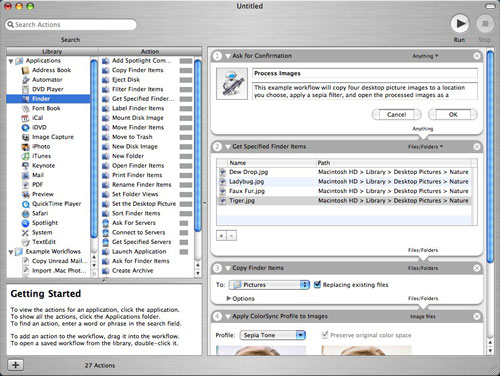
The potential for Automator is tremendous. However, I found myself wanting many more actions than what is supplied with Tiger. Although Apple has pretty good documentation on their developer site of how to create your own actions, doing so basically nullifies one of the major attractions to Automator, which is bringing this sort of automated functionality to the masses. There are presently some Automator actions that are available for download from Apple's web site. With further development and support from the community, Automator could very well become one of the most useful items in Tiger, but as it stands now, I'm not sure how much use the majority of users will get out of it.
TextEdit
As a Windows user, I always hated Wordpad, but early on, Notepad was too simplified for a lot of tasks - forcing me to use Word when I didn't exactly want to. The Windows 2000/XP version of Notepad fixed a lot of my complaints, and then Notepad became much more of a useful tool to me. I've seen a similar transition with OS X's TextEdit in Tiger, not to say that TextEdit wasn't already infinitely more capable than Notepad, but with Tiger, it has gone from a pretty impressive text editor to a more full-featured editor, while still maintaining the simplicity of TextEdit.To me, the biggest feature of TextEdit is the ability to now save to HTML. Not only will TextEdit save in HTML formats now, but the HTML saving options in TextEdit are options that I wish all applications which produce HTML had. You can select from strict or transitional HTML 4.01 or XHTML 1.0, and you can choose whether or not you want to use CSS. The HTML produced by TextEdit is just as simple and as clean as you'd expect from a text editor that still appears hardly intimidating. The only requirement for saving as HTML is that you need to be in TextEdit's rich text editing mode.
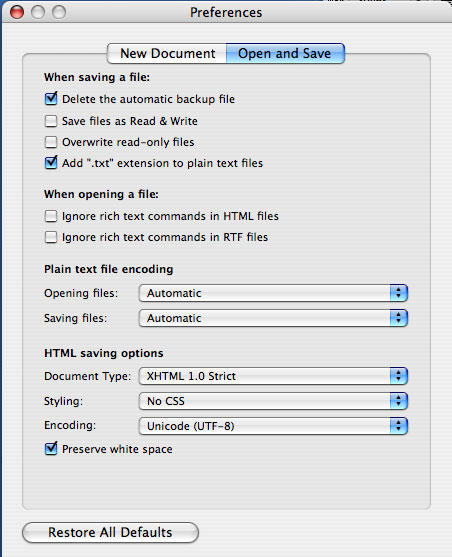
There's a new checkbox in the Save dialog box - "If no extension is provided, use .txt". That change is pretty self-explanatory.
Hitting the zoom button in TextEdit now seems to expand the window to the full width of the screen, instead of just zooming to a larger, better proportioned window. The button now acts as "maximize", which I don't like so much (surprisingly enough, because my first reaction to the zoom vs. maximize debate the first time I used OS X was that I missed the ability to maximize windows). You can get the same functionality as Panther's TextEdit by enabling Word Wrap, but when doing so, you get a fairly useless layout border around your text as seen below:
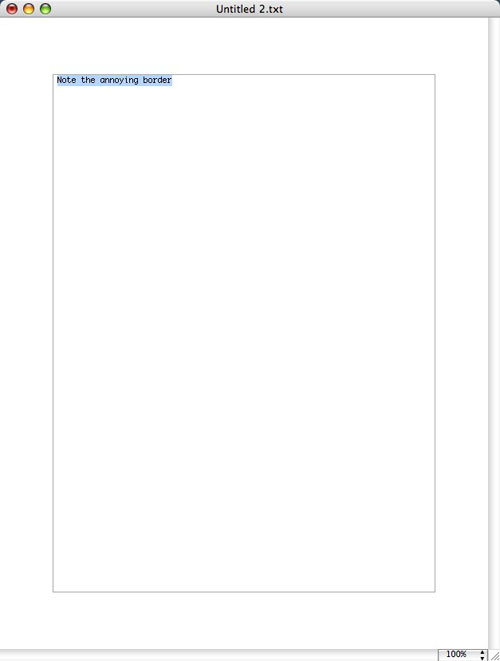
New Calculators
Tiger has three new calculators, two of which are particularly useful to engineers and students in engineering.The programmer's calculator allows you to perform binary math and bitwise operations, which can definitely come in handy. The calculator also has the option of showing you the ASCII and Unicode representation of any of your calculations, which is also very useful depending on the type of project that you're working on. One of my last projects as a student of Computer Engineering involved building a hardware dictionary scanner - needless to say that having the programmer calculator back then would have been a handy tool.
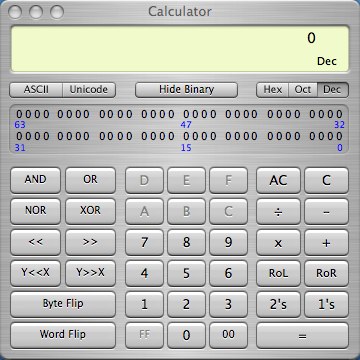
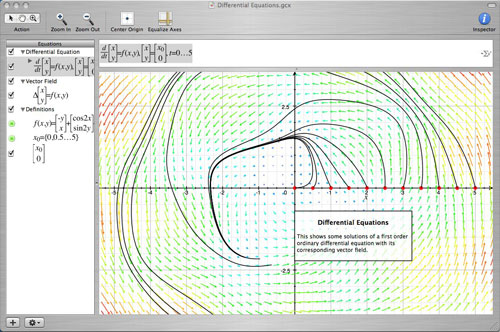
The calculator improvements to Tiger are very student/engineer oriented and, as such, are much appreciated. Given that Tiger only costs $69 with a student discount, it would seem that Apple definitely has the needs of the computer savvy student as one of their top priorities. If I were still an engineer in school, Tiger would be a no brainer upgrade for me.
The final calculator to talk about is the new Calculator widget that's a part of Dashboard. Originally, when I saw the Calculator widget demonstrated as a part of Dashboard, I was extremely excited. When preparing most of my articles, I had a ton of fairly simple, but calculator-requiring math to do, so I ended up using the Calculator a lot. On my PC, I have a keyboard with a calculator button on it that'll launch calc.exe, but under OS X, I have no such convenience. So essentially, what the Calculator widget would give me is similar functionality.

My biggest complaint about the Calculator widget is that it places commas automatically in your number, and the font that the widget uses makes the commas entirely too large and a bit distracting. I understand that a smaller comma would be easily confused with a decimal point, so my solution is an option to turn off the commas, which isn't present in the current version of the Calculator widget.
There's also a somewhat annoying bug with the widget that happens if you backspace to clear all of the numbers in an entry. Normally, hitting the escape key clears the input in the Calculator, but sometimes I have a habit of just backspacing to delete all of the numbers. If I do so, the Calculator widget appends a zero to the start of any input. It doesn't change the outcome of the calculations - there's just an annoying zero at the front of my number. Hitting escape will clear the problem.
DVD Player
I ranted about Panther's DVD player quite a bit in a previous article on the mini, and just as I expected, the issues I raised in that article have not been addressed by Tiger. Tiger's de-interlacer and scaler are absolutely horrible and unacceptable by today's standards. While I didn't conduct the same level of tests that I did for my review of the DVD player with the mini, all tests that I did run exhibited the same combing artifacts and poor scaler quality as I had seen in Panther. Given the fact that apparently many Mac users had complained about Panther's DVD player in the past, I'm quite surprised that it wasn't fixed in Tiger.CPU utilization doesn't appear to be fixed either; DVD playback on the Mac mini continues to eat up a minimum of 40% of the machine's CPU time. Although, I haven't seen it peak at 65% since the upgrade to Tiger.
iChat AV 3 & Quicktime 7
Both of these applications do receive extensive updates, but honestly, I've not used either enough to even begin to feel comfortable with posting my opinions of them. The support for the H.264 codec is extremely important and I'm hoping that it will live up to its hype in future usage models.iChat finally supports the display of multiple groups at the same time, instead of having to switch between groups to make them visible, which makes it a much more reasonable IM client.
I will do my best, if the desire is still there, to comment on these applications more in a future Mac article.
Performance in Tiger
The one thing that excited me more than anything else about getting and using Tiger was that everyone had lauded OS X for being the one OS that had improved in performance with every iteration. Being a Windows user, this was a complete reversal of my thinking - as each new iteration of Windows was an excuse for me to build a ridiculously powerful machine by my old standards, to feel even remotely at home under the latest version of Windows.But it would appear that I may have missed the boat, as performance in Tiger is a mixed bag. I'd say that overall performance in Tiger is an improvement over Panther, but there are some definite exceptions to the rule.
The biggest exception, from my perspective, is the fact that menu highlights always seem to just barely trail my mouse pointer in Tiger, whereas Panther kept up very well. At first, I thought that I was just imagining things, but then I set up a G5 test bed with two identical hard drives; the only difference being one drive had Panther while the other had Tiger. After booting them back to back, it's clear that my worries were founded. Tiger's menu highlight does seem to be slightly more laggy than Panther's.
Other areas of performance show definite improvements in Tiger, but what's interesting to me is that subjective performance impacts vary greatly (for me) depending on the type of system that I'm using. For this article, I used Tiger on four different modern day Macs: two Powermac G5 systems (dual 2.5GHz and dual 2.0GHz), one Mac mini and a 15" PowerBook G4.
Performance using Spotlight is pretty impressive on all three systems on which I've tried Tiger. On the mini and the PowerBook G4, it is definitely slower than the G5, thanks to their slower hard drives, but it is still fairly quick to search and bring up results. Spotlight on the G5 is lightning quick, although the results don't all pop up at the same time. Within a second, you have your entire list of search hits at the upper right hand corner of your screen. What's interesting here is that because Spotlight performance isn't something that I could quantify in Panther (since Spotlight obviously wasn't a feature of Panther), the PowerBook and mini feel slower in Tiger to me than they were in Panther. It's not because the OS is actually slower, but it's because my usage models have changed with Tiger - thus, putting more emphasis on fast hard disk performance. I'd also say that there's a pretty noticeable performance difference in Spotlight between the mini's 5400RPM 2.5" hard drive in comparison to my older PowerBook's 4200RPM 2.5" hard drive.
I/O performance appears to have improved by a noticeable amount in Tiger, especially on the G5. Disk accesses seem quicker, although I'm not certain if that's improvements to the disk side of I/O or if it is better at memory management, caching, or what. Regardless, those two areas of performance definitely improved.
There was a noticeable improvement in performance on the G5, with the biggest improvements being in UI performance. The UI seems a lot more responsive (especially at higher resolutions), scrolling is faster/smoother and the OS in general just feels a lot snappier. Scrolling performance throughout the OS has improved tremendously; it's not smooth enough to the point where I feel like I can enable the smooth scrolling option and get the same feel as I could on a PC, but performance is still definitely improved. My only complaint with UI performance continues to be the menu highlighting issue from earlier. It's not a show stopper, but it's definitely something noticeable.
Exposé performs basically identical to Panther under the new OS, regardless of what system I'm talking about. The Mac mini continues to have issues at higher resolutions, as Exposé stops being smooth and now even Dashboard is choppy on the mini. Again, the problem here is a sheer lack of video memory. I do hope that Apple updates the mini to include a better GPU as well as one with a larger local memory very soon, now that Tiger is out. So much of the beauty of the Dashboard is that you can access it so quickly and seamlessly, that when you get to use a choppy version of the feature, it does slightly ruin the effect of it.
Although Apple promises better battery life management on notebooks with Tiger, I didn't notice any major improvements during my multiple months with Tiger loaded on the PowerBook. Obviously, battery life improved over time, but I can't help but feel that even with the final version of Tiger, battery life is no better, and maybe even slightly worse (especially in sleep states) than Panther. I don't have any quantitative backing for these claims yet - it's just a feeling at this point.
The main thing to keep in mind is that all four of the systems I tried under Tiger performed, overall and at worst, no differently than under Panther. In many cases, there were some pretty hefty speedups that were definitely noticeable. I'd say the biggest performance gains that I noticed were on the G5 machines, despite spending more time with Tiger on the G4 based clients. If you have a G5 with enough video memory, Tiger and all of its new features should be smooth sailing for you.
I did perform some basic tests to see how Tiger stacked up to Panther in various performance categories. For these tests, I used a Powermac G5 dual 2.0GHz using a 250GB Maxtor MaXLine III SATA drive (each OS had their own drive with their own clean install of the OS).
Both Tiger and Panther took basically the same amount of time to start up, with Panther getting from pressing the power button to the desktop in about a second quicker than Tiger.
| Panther | Tiger | |
| System Startup in Seconds (Lower is Better) | 49.1 | 50.1 |
The Let1KWindowsBloom test times how long it takes to open 1000 windows:
| Panther | Tiger | |
| Window Creation Time in Seconds (Lower is Better) | 44 | 8 |
It's not the best test in the world, but it is interesting that there is an order of magnitude of performance improvement of Tiger over Panther. I'm not totally convinced that this isn't a bug with the test yet, however, so I wouldn't put too much faith in it just yet.
I wanted to see if Tiger improved the absolutely dismal Doom 3 performance of OS X:
| Panther | Tiger | |
| Doom 3 Frame Rate (Higher is Better) | 35.9 | 39.5 |
And although a 10% performance increase is nothing to scoff at, there's no getting around the fact that Doom 3 performance on the Mac is absolutely unacceptable. The average frame rates that I'm reporting here don't even begin to tell the full story. There's just far too much stuttering during the actual game for it to even be remotely playable. It looks like Tiger does improve gaming performance though.
For my final test, I ran a quick decompress test of a 140MB archive to see if I/O performance really improved in Tiger.
| Panther | Tiger | |
| Archive Extraction in Seconds (Lower is Better) | 22.93 | 21.5 |
Tiger boasted a 6% lower time, but what's interesting is that Tiger's time was much more reliable than Panther's. There were many occasions when Panther actually took significantly longer than Tiger, but the reverse was never true.
Benchmarking under OS X continues to be a pain, but there's an early try at quantifying the performance differences between Tiger and Panther. I can say, in confidence, that if you're a G5 user, you won't be disappointed. For G4 users, I can't say that the performance improvement was as drastic, but it definitely wasn't negative.
Final Words
Bear in mind that I'm still just as much of a Windows/PC user as I've ever been (potentially now with more open of a mind), but the argument that Apple charging $130 for Tiger is like Microsoft charging $130 for Service Pack 2 is quite possibly the worst argument that I've ever heard. On my best, most verbose day, I couldn't come up with enough stuff to write about a service pack as I've talked about today here with Tiger. Like it or not, there is a lot that has changed in Tiger, but obviously, the question is whether or not it is worth the $129 entry fee.For me, the answer is simple - I'm too much of an early adopter to not want to jump on Tiger and install it any and everywhere that I possibly can. Features like Dashboard and Spotlight alone were enough to sell me on the OS, but I think that as I become more comfortable and accustomed to using Smart Folders and other smaller improvements, Tiger will be even more of a sell for someone like me.
But I have to find it difficult recommending a product that's clearly unfinished, and clearly not without bugs. None of the bugs that I encountered were show stoppers, but I'm not one to support pre-release products that are being shipped as final. So, if you're expecting a perfect user experience with Tiger, you'll be close, but not quite there. I'm hoping that the 10.4.1 update fixes all of my issues, but for now, don't expect a flawless $129 experience.
For students, given that the price of Tiger is only $69, I'd say there's no reason not to make the move. Engineers will definitely appreciate the inclusion of a programmer's calculator as well as Grapher, and if you're in college, chances are that you can use Spotlight's forgiveness when it comes to poor organization.
Of course, then there's the obvious comparison to Longhorn. I don't believe that Tiger today will be what Longhorn is when it is eventually released, but all indications seem to point to Apple evolving Tiger quite a bit over the coming years. Enabling Quartz 2D Extreme and applications taking more advantage of Dashboard, Spotlight and Tiger's Core technologies will improve things tremendously down the road. Although there has not been much said about what's going to happen now that Tiger is done, I can't help but feel like Tiger is very much a work in progress and what we've been show thus far is the first part of a very interesting evolution of technology. Then again, maybe I'm completely off base, and maybe it's just that I expected Tiger to be so much more than it ended up being. Maybe it's wishful thinking being born out of a case of software buyer's remorse. Only time will tell.
What's important to me is that the features and usage that originally intrigued me about the Mac platform have not changed, and if anything, the entire package is made more tempting by Tiger. I am very curious to see if Microsoft can truly duplicate or surpass the overall package that I've been so impressed with when it comes time for Longhorn - they sure seem to be talking like that's the case.
Looking at today, it's an important day for Apple, a day to celebrate a very impressive OS launch - but I get the feeling that no one at Apple is celebrating quite yet. It seems like there's still quite a bit of work left to be done.







